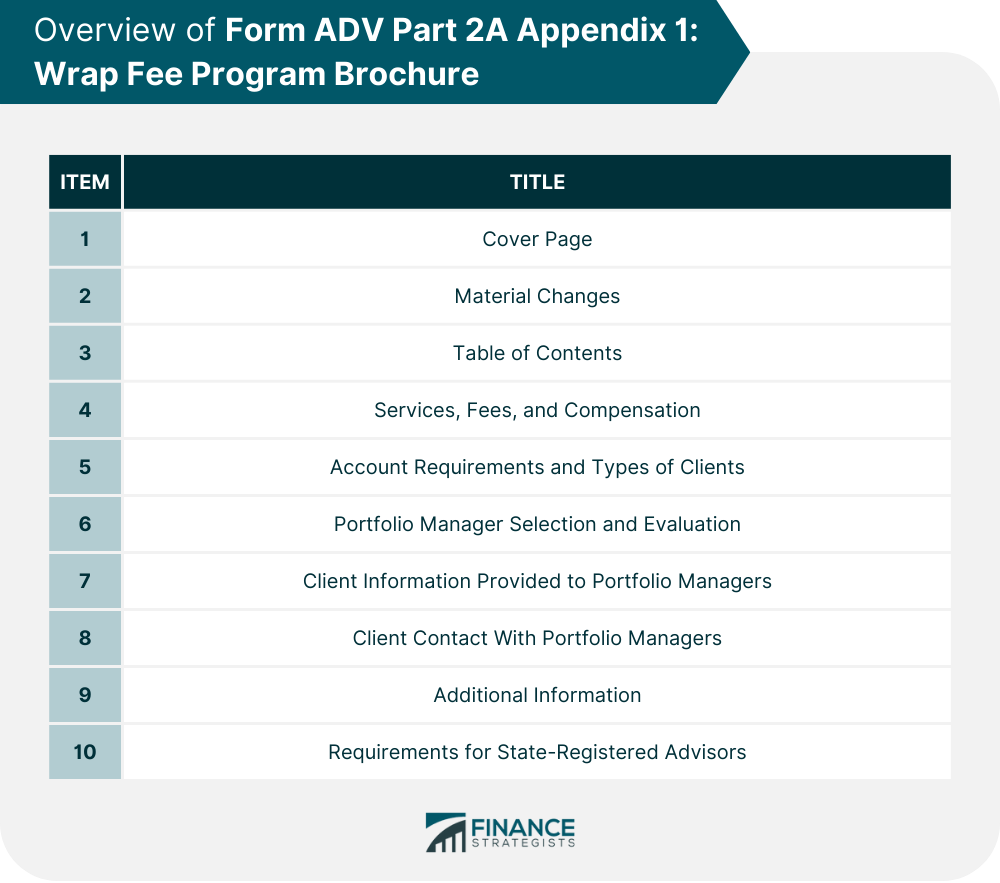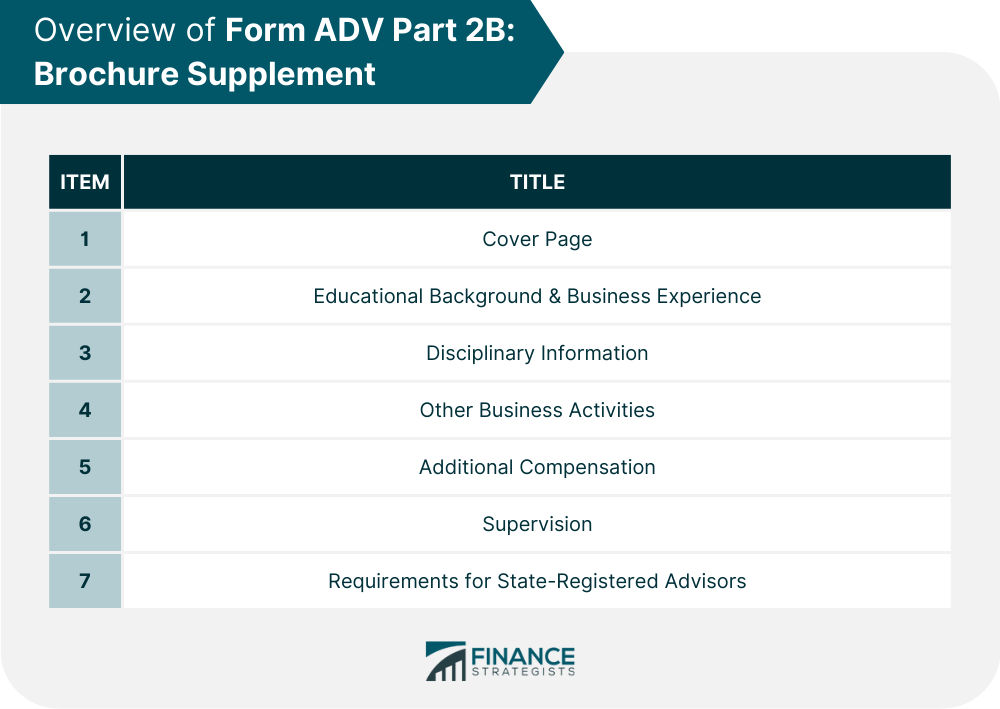SEC Form ADV Part 2 is included in a collection of documents, known as the Form ADV, that professional investment advisors, whether they are financial advisory firms or individual financial advisors, must file with the U.S. Securities and Exchange Commission (SEC). The complete Form ADV discloses crucial information about an investment advisor’s services, fees, potential conflicts of interest, and disciplinary information. It also helps the SEC monitor and regulate all registered investment advisors. Meanwhile, Form ADV Part 2 is a narrative document with extensive information on an advisor’s business operations, services, charges fee structure, and background. Generally, this document has two parts. The information relevant to clients regarding the investment advisory firm is presented in Part 2A. In contrast, Part 2B is a supplemental report with details on each employee of the organization who provides financial advice to clients. Aside from Part 2A and Part 2B, firms that sponsor a wrap fee program must submit Appendix 1, also known as the Wrap Fee Program Brochure. Part 2 of SEC’s Form ADV is intended to provide clients with the details they need to make an informed decision about a potential investment advisor. It also aims to protect clients from dealing with unreliable firms. Part 2A of the Form ADV, also known as the firm brochure, contains narrative information that is divided into the following 19 items: The first part of the section and this item includes the investment advisor’s or investment advisory firm’s name and address, contact information, website address, and the brochure’s publication date. The form is updated yearly, and this second section reviews and identifies any modifications or changes in the brochure’s content. The table of contents lists all the sections and pages with the same headings, allowing clients to quickly find the necessary information they are looking for. This section describes the length of time the advisor or advisory companies have been in business, the primary owner, types of advisory services provided, how they customize services for clients, and the value of assets managed. This is an essential item for clients to check since it outlines the fee structure their advisors. All extra advising fees and costs that are negotiable are also clearly mentioned. Fees that depend on a client’s portion of capital gains or capital appreciation are revealed in this section. Also, advisors must disclose if they are simultaneously managing many accounts and if any potential conflicts of interest may arise due to this setup. Advisors must provide a profile of the typical clients they offer services to. Additionally, information on account maintenance and creation must be explained. This section looks into advisors’ methods for analysis, investment strategies, and what risks clients should be aware of. In this item, advisors must disclose any federal or state disciplinary history of themselves or the organizations they are associated with. This should particularly include incidents of the past ten years. Advisors must disclose other activities conducted in the financial industry, including affiliations with any broker-dealer or insurance company. This also includes any pending registration and possible commissions with financial service companies. This is an important disclosure, as it provides clients with information related to the team of advisors and their code of ethics. It also requires an advisor to disclose any potential conflicts of interest that may arise from participation in advisory clients’ transactions or personal trading. This section includes the brokerage practices of the firm, such as research and broker selection criteria. Also, any financial incentives received from brokers, such as commissions, must be listed. The firm must explain the frequency and manner in which a client’s accounts will be reviewed and monitored. This includes any monitoring or internal control systems that will take place. An advisor must disclose all referral fees or other compensation from outside firms due to client referrals and soft dollar arrangements, which can significantly affect the advice they provide. For any form of custody or possession of assets, advisors must provide information on the types and size of accounts held in custody and how client funds or securities will be safeguarded. The role of third parties, if any, must also be outlined. An advisor must disclose the scope of discretion they have on clients’ accounts. Any limitations or restrictions must also be specified. This section explains how an advisor will vote proxies on behalf of their clients and clarifies any special instructions needed for a client to specify their voting choices. An advisor must report any financial information that may impair their capacity to offer services to clients, such as bankruptcies or other significant events relating to their business. Advisors registered with a particular state also need to comply with specific requirements outlined by their respective states. This includes mandated disclosures about ownership, control, disciplinary actions and any other additional information required by the state. Appendix 1 of Form ADV Part 2A, also known as a wrap fee program brochure, provides information on the firm’s portfolio management services and qualifications. Similar to the firm brochure, this document also requires a cover page section with basic information about the firm and advisor, a material changes section for the updates, and a table of contents to assist the reader in navigating the document. Following the introduction, Form ADV Part 2A Appendix 1 contains several sections that provide further details on a firm’s services: Clients learn from the section precisely what services they are receiving under the program, the applicable fees for each service, and other forms of compensation or financial incentives that the firm may receive. This section describes the types of accounts and clients who can participate in a wrap fee program, including eligibility criteria and any minimum or maximum account size required. This section details how a firm selects and evaluates an assigned portfolio manager. It also includes information on whether an assigned portfolio manager is related to other individuals in the firm and the possible conflicts of interest that may arise from that setup. This portion of the brochure details what client information portfolio managers have access to and how often that information is updated. Limits on a client’s ability to communicate with portfolio managers are also indicated here. Important information not previously shared in the rest of the brochure appears in this section. Requirements and specialized disclosures needed by advisors registered in certain states are also included here. Form ADV Part 2B is the brochure supplement where firms give clients information on each individual who formulates investment advice for that client and has direct client contact or makes discretionary investment decisions for that client’s assets. Preceded by a cover page, this section of the form also includes the following information on the advisors: The brochure supplement must list the supervised individual’s post-high school education and the details of the last five years of their business experience. The document must reveal any previous legal or disciplinary incident, especially those that occurred during the past ten years. Information about other business activities and any significant conflicts of interest that may arise from them must be disclosed. It must also include information about any bonus or non-cash compensation they get for selling investment products and incentive schemes. Any additional compensation received by an advisor for providing advice must be included in this section. This can consist of information about sales awards and other similar rewards. Necessary information about the supervision of the individual who gives advice must be included in this section. Details such as the name, title, and contact number of this person’s supervisor must also be provided. Additional information required by states should be included by advisors registered in certain states. This section can include any specialized disclosures needed. The SEC Form ADV is available on the Investment Advisor Public Disclosure (IAPD) website. This website is open to the public so potential clients can view an advisor’s background and services before investing. Potential clients can search the Form ADV of a firm or investment advisor by inputting their name, location, Central Registration Depository number, or SEC license number on the website. If a firm has multiple listings, it is essential to verify which ones include Investment Advisor (IA) on their profile for more information about them and their recent Form ADV filing. SEC Form ADV Part 2 is included in a collection of documents known as the Form ADV, which investment advisors and firms file with the SEC. This portion of Form ADV discloses crucial information that helps clients make informed decisions about the firms they select. This document has two parts. Part 2A, known as the firm brochure, contains general narrative information about the firm. Meanwhile, Part 2B is a supplement that contains specific details on each employee of the organization who provides financial advice to clients. Aside from Part 2A and Part 2B, firms that sponsor a wrap fee program must submit a Wrap Fee Program Brochure, also known as Appendix 1. By reading through the entire SEC Form ADV Part 2, clients will gain a comprehensive overview of an investment advisor or firm’s business and activities. This can assure them that their partners are legitimate and are not engaged in deceitful practices.What Is SEC Form ADV Part 2 Brochure?
Form ADV Part 2A: Firm Brochure
Cover Page
Material Changes
Table of Contents
Advisory Business
Fees & Compensation
Performance-Based Fees and Side-By-Side Management
Types of Clients
Methods of Analysis, Investment Strategies, and Risk of Loss
Disciplinary Information
Other Financial Industry Activities and Affiliations
Code of Ethics, Participation or Interest in Client Transactions and Personal Trading
Brokerage Practices
Review of Accounts
Client Referrals and Other Compensation
Custody
Investment Discretion
Voting Client Securities
Financial Information
Requirements for State-Registered Advisors

Form ADV Part 2A Appendix 1: Wrap Fee Program Brochure
Services, Fees, and Compensation
Account Requirements and Types of Clients
Portfolio Manager Selection and Evaluation
Client Information & Contact with Portfolio Managers
Additional Information & Requirements for State-Registered Advisors

Form ADV Part 2B: Brochure Supplement
Educational Background & Business Experience
Disciplinary Information
Other Business Activities
Additional Compensation
Supervision
Requirements for State-Registered Advisors

How to Access Form ADV
Final Thoughts
Form ADV Part 2 Brochure FAQs
The Form ADV Part 2 Firm Brochure must be delivered to each of the firm's current clients and to any new clients before entering into a contract with them.
The Form ADV Part 2 Firm Brochure must be delivered to current clients annually or after the firm has made a material change in its services or fees. For new clients, the Form ADV Part 2 Firm Brochure must be provided before an agreement is finalized.
The Form ADV Part 2 Firm Brochure can be delivered electronically if the client has consented to receive the information in that form or if they are already familiar with the firm. However, clients must confirm these communications by email or other written means.
The Form ADV Part 2 Firm Brochure must be updated and filed with the SEC annually or if there is a material change in services or fees. These updates can include changes in personnel, contact information, and other vital details that could affect clients' investments.
Firms may prepare multiple Form ADV Part 2 Brochures if they offer several advisory services, each with unique terms, fees, or compensation arrangements. It is important to note that any changes in the services provided must be reflected and updated with the SEC.
True Tamplin is a published author, public speaker, CEO of UpDigital, and founder of Finance Strategists.
True is a Certified Educator in Personal Finance (CEPF®), author of The Handy Financial Ratios Guide, a member of the Society for Advancing Business Editing and Writing, contributes to his financial education site, Finance Strategists, and has spoken to various financial communities such as the CFA Institute, as well as university students like his Alma mater, Biola University, where he received a bachelor of science in business and data analytics.
To learn more about True, visit his personal website or view his author profiles on Amazon, Nasdaq and Forbes.











